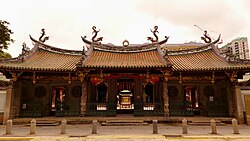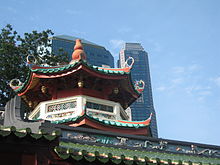天福宮 | |
 Thian Hock Keng Temple | |
| Monastery information | |
|---|---|
| Full name | Thian Hock Keng Temple |
| Order | Mazuism, Taoism, Confucianism, Buddhism |
| Established | 1821–1822 |
| Architecture | |
| Style | Hokkien architecture |
| Groundbreaking | 1839 |
| Completion date | 1842 |
| Construction cost | 30,000 Spanish dollars |
| Site | |
| Location | Telok Ayer Street |
| Country | Singapore |
| Coordinates | 1°16′51.8″N 103°50′51.1″E / 1.281056°N 103.847528°E |
| Website | www |
| Designated | 6 July 1973 |
| Reference no. | 5 |
| Thian Hock Keng | |||||||||||
|---|---|---|---|---|---|---|---|---|---|---|---|
 Keng Teck Huay Pagoda | |||||||||||
| Traditional Chinese | 天福宮 | ||||||||||
| Literal meaning | Palace of Heavenly Happiness | ||||||||||
| |||||||||||
Thian Hock Keng[1] (Chinese: 天福宮; pinyin: Tiānfú Gōng; Pe̍h-ōe-jī: Thian-hok-keng or the Tianfu Temple, literally "Palace of Heavenly Happiness"),[2] is a temple built for the worship of Mazu, a Chinese sea goddess, located in Singapore. It is the oldest and most important temple of the Hokkien (Hoklo) people in the country. Another shrine at the back is Buddhist dedicated to Guanyin, the Mahayana Buddhist bodhisattva of mercy.
Thian Hock Keng was gazetted as a national monument on 6 July 1973.[3]
- ^ "About Us", Official site, Singapore: Thian Hock Keng, 2007. (in Chinese) & (in English)
- ^ Cite error: The named reference
rootswas invoked but never defined (see the help page). - ^ William Campbell (3 August 1973). "Ancestors' memory saves a temple". The Straits Times. p. 10.